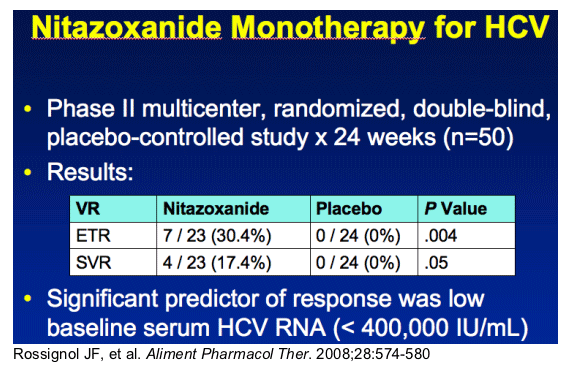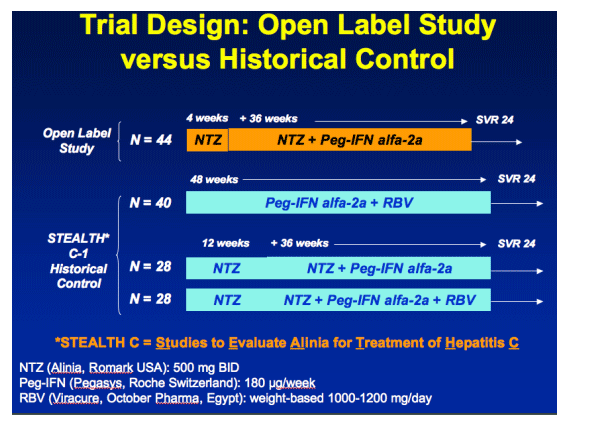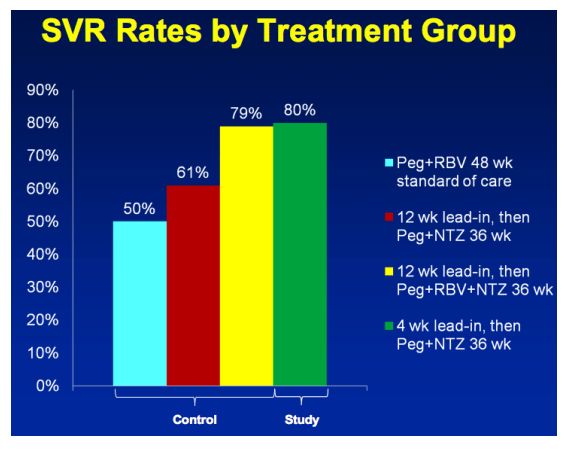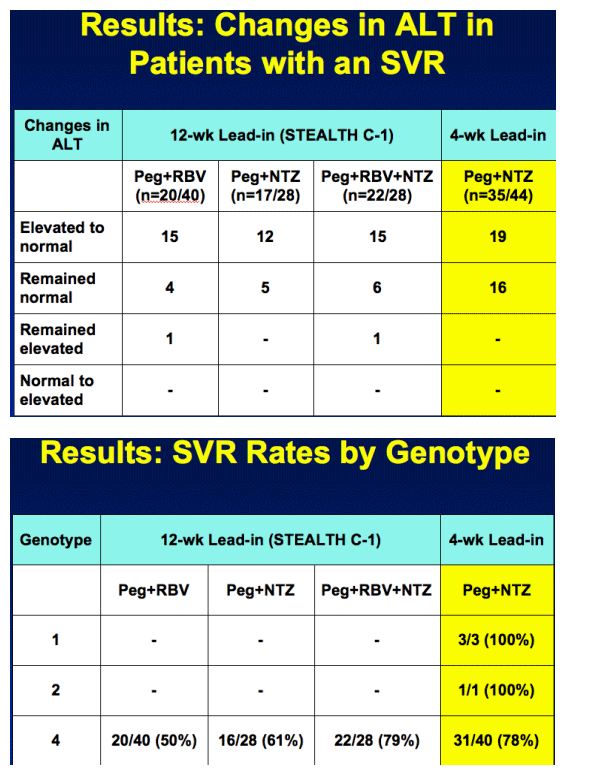 |
 |
 |
| |
Evaluation of a 4 Week Lead-in Phase with Nitazoxanide (NTZ) prior to Peginterferon (PegIFN) plus NTZ for Treatment of Chronic Hepatitis C: Final Report
|
| |
| |
Reported by Jules Levin
AASLD Oct 31-Nov4 2008 SF, CA
From Jules: a concern raised about NTZ is that not all patients respond, some patients may not respond at all to NTZ and the reason for this is not understood.
Jean-Franšois Rossignol, M.D., Ph.D.,1,2 Asem Elfert, M.D.,3
Emmet B. Keeffe, M.D.1,2
1Romark Institute for Medical Research, Tampa, FL, 2Division of Gastroenterology and Hepatology, Department of Medicine, Stanford University Medical Center, Stanford, CA, 3Department of Gastroenterology and Hepatology, University of Tanta, Faculty of Medicine, Tanta, Egypt
AUTHOR SUMMARY
4 weeks of NTZ monotherapy followed by 36 weeks of peginterferon alfa-2a plus NTZ achieved a SVR of 80%, which was similar to historical studies of dual or triple therapy using a 12-week NTZ lead-in
NTZ lead-in phase can be reduced to 4 weeks
Dual therapy with peginterferon alfa-2a plus NTZ in this study are not different from triple therapy including ribavirin in STEALTH C-1
AUTHOR CONCLUSIONS
Nitazoxanide significantly improves response to peginterferon-based therapy in patients with chronic hepatitis C
Clinical trials in interferon-na´ve patients and nonresponders to peginterferon plus ribavirin are needed in patients with chronic hepatitis C genotype 1 and are underway in the U.S.
Further studies of dual therapy with peginterferon plus ribavirin are warranted
Nitazoxanide
Background
Broad spectrum of clinical activity against parasites, anaerobic bacteria and viruses
Initially developed for treatment of parasites, and licensed by FDA (Alinia) for treatment of Cryptosporidium and Giardia in 2002
Antiviral activity against HCV and also HBV discovered by serendipity in patients with Cryptosporidium infection and AIDS who were coinfected with HCV or HBV
First member of new class of small molecules, the thiazolides, that are cell signal modulators
Potent inhibitor of HCV in replicon systems1
Mechanism of action: enhances intracellular activity of interferon, by induction of PKR and eIF2a phosphorylation2
Does not induce resistance via mutations in HCV replicon3
1Korba BE, et al. Antir Res. 2008;77:56-63. 2Elazar M, et al. Hepatology. 2008;48:1151A (#1881).
3Korba BE, et al. Antimicrob Agents Chemother 2008;52:4069-4071.

Nitazoxanide Combination Therapy
Rationale for Lead-in Phase
Laboratory studies showed that pretreatment of HCV replicons with NTZ potentiated subsequent treatment with NTZ plus IFN1
Pilot clinical studies showed greater efficacy if NTZ was administered before peg-IFN plus RBV
Initial NTZ lead-in phase selected was 12 weeks, followed by triple therapy;2 duration of lead-in phase required for optimal efficacy unknown
1Korba BE, et al. Antir Res. 2008;77:56-63.
2Rossignol JF, et al. J Hepatol. 2008;48:S30
Nitazoxanide 4-Week Lead-in Study
Objectives
Primary objective
To evaluate the effect of reducing the duration of nitazoxanide lead-in therapy from 12 weeks to 4 weeks in patients with chronic hepatitis C subsequently treated with nitazoxanide plus peginterferon
Secondary objective
To further evaluate the antiviral efficacy of dual therapy with nitazoxanide plus peginterferon without ribavirin

Inclusion Criteria
- Age ≥18 years
- Chronic hepatitis C ≥6 months based on detectable anti-HCV and serum HCV RNA
- Any genotype (G4=40; G1=3; G2=1)
- Evidence of chronic hepatitis on liver biopsy obtained within 3 months of enrollment
- Compensated liver disease
- Na´ve to antiviral therapy
Key Exclusion Criteria
- Prior interferon-based therapy
- Decompensated hepatic function
- Other causes of liver disease
- History of alcoholism or alcohol use >40 g/d
- Coinfection with HBV or HIV
- Pregnancy or inadequate birth control
Medical conditions making it unlikely that a course of therapy could be completed
Methods
Open label study conducted at U. of Tanta in Egypt
Drug treatment:
-- Nitazoxanide 500 mg BID with food
-- Peg-IFN alfa-2a 180 μg/week
Clinic visits every 4 weeks with physical exam and laboratory tests for safety and efficacy
Serum HCV RNA measured by Bayer Versant v. 3.0 (LLD=615 IU/mL) and Abbott m2000 (LLD=12 IU/mL)
-- Patients considered undetectable only if HCV RNA < LLD by both assays
Data analyzed by intention-to-treat





|
| |
|
 |
 |
|
|